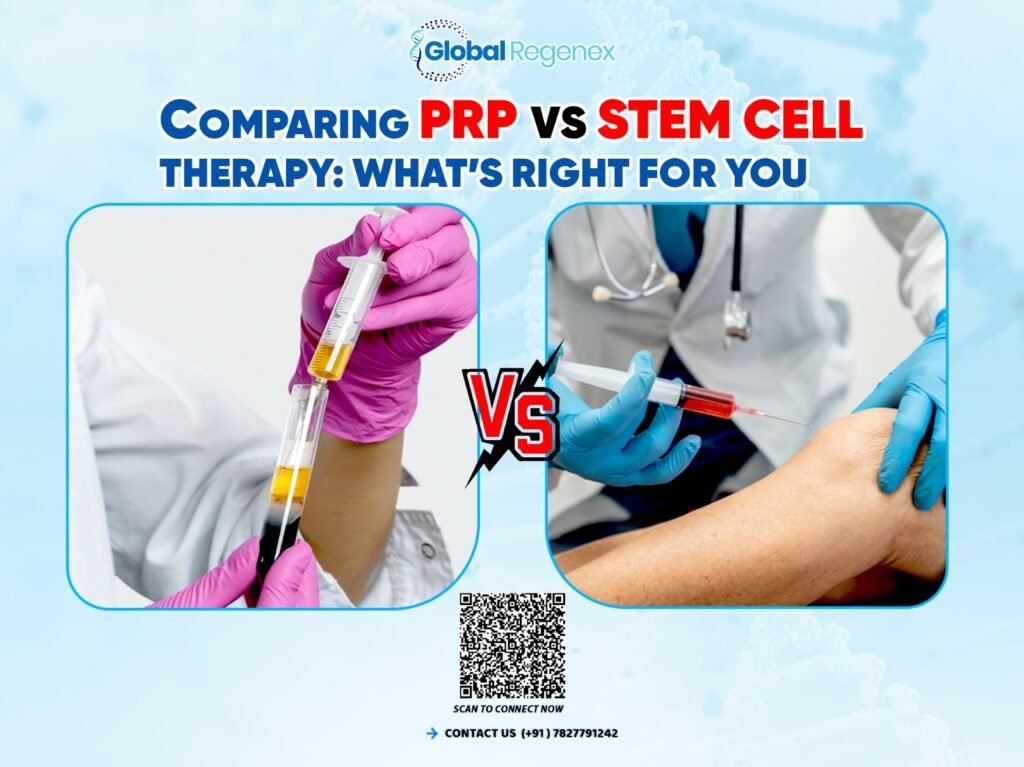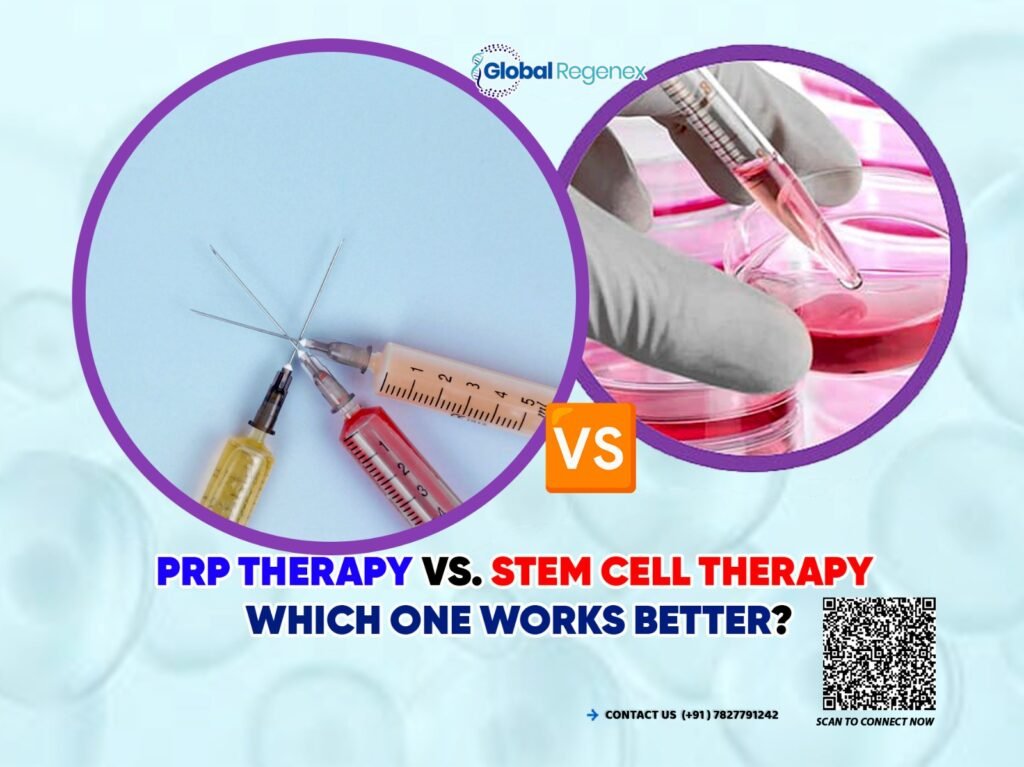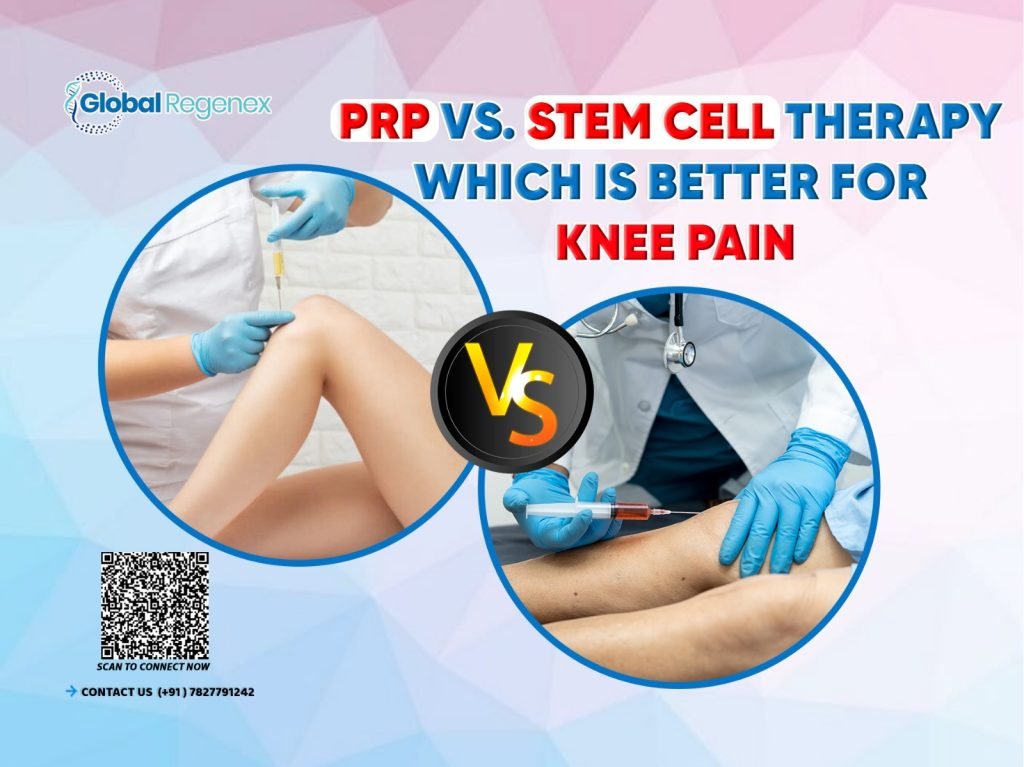Comparing PRP vs Stem Cell Therapy: What’s Right for You

Summary: Regenerative medicine is changing how we heal from injuries, arthritis, and chronic pain. PRP (Platelet Rich Plasma) therapy and stem cell therapy are two of the most requested treatments today, and both treatments’ mechanisms require the stimulation of your body’s natural healing process. PRP activates the healing process by amplifying tissue repair through growth factors. Stem cell therapy goes a step further by regenerating new tissues and repairing damaged tissue. Understanding how PRP and Stem Cell Therapy differ will help you decide which is better for your condition. Have you ever questioned why your joint pain, sports injuries, or chronic inflammation continue to recur despite professional management and care? Advanced regenerative medicine provides a solution in the form of PRP and Stem Cell Therapy, both of which utilize components of your own cells to naturally heal and regenerate damaged tissues. PRP and stem cell therapy are similar concepts, but they have different complexities and address different needs. Whether to utilize PRP or Stem Cell therapy depends on your diagnosis, the severity of the condition, and your goals of healing. Let’s look at how they work, their advantages, and what might be best for you specifically. What Is PRP Therapy? The Platelet-Rich Plasma therapy will take the blood from the patient through pricks, put the blood samples in the centrifuges to separate the platelets, and then inject the concentrated platelet plasma into the injured area. Platelets are loaded with growth factors — endogenously produced proteins that trigger tissue healing, resolve inflammation, and trigger collagen synthesis. Common Uses for PRP Treatment: Early osteoarthritis and joint ache Tendinopathy or ligament sprains (such as tennis elbow Hair restoration for thinning hair Rejuvenation and anti-aging treatment for the PRP is less invasive, safe, and effective for mild to moderate diseases where the body still possesses enhanced healing capability. Understanding Stem Cell Therapy The stem cell therapy does one better than the PRP. Whereas the PRP encourages healing, the stem cell therapy actually builds new tissue. Stem cells are unique cells that have the ability to be reprogrammed into other cell structures, like bone, muscle, cartilage, or nerve cells, to replace one’s that have been damaged. These come from the bone marrow, the fat tissue (adipose-derived), or the umbilical cord. Following transplantation to the injured site, the stem cells will get to work repairing tissue, restoring function, and reducing inflammation. General Use of Stem Cell Therapy: Progressive diseases and degeneration of joints Spinal injury and neurologic damage Diabetic ulcers or foot ulcers Autoimmune diseases and neurologic diseases Key Difference Between PRP and Stem Cell Therapy Feature PRP Therapy Stem Cell Therapy Source Patient’s own blood. It can be derived from bone marrow, fat tissue, or umbilical cord. Main Function It boosts natural healing Regenerates damaged cells. Best Suited For Mild to moderate conditions. Severe or chronic conditions. Duration of Result Short to medium time. Long-term or permanent. Invasiveness Simple injection A little more advanced procedure. Cost Affordable Slightly higher due to complexities. Recovery Time Fast 1 -2 days A few days or weeks. Outcome Improved pain and mobility It regenerates tissue and sustains function. Benefits of Choosing PRP Therapy for Your Condition Here are some benefits of PRP therapy: Quick Recovery: Simple outpatient procedure with minimal downtime Natural and Safe: Uses your own blood, avoiding allergic reactions Cost-effective: Ideal for early intervention before the condition worsens Improves Mobility: Reduces stiffness and enhances flexibility in joints Cosmetic Use: Helps rejuvenate skin and promote hair growth naturally Benefits of Choosing Stem Cell Therapy in India for Your Condition Here are some benefits of stem cell therapy: Regenerative Healing: Creates new tissue, not just temporary relief Long-term Results: Reduces pain and inflammation over extended periods Restores Functionality: Improves mobility and muscle strength Reduces Need for Surgery: A viable alternative for knee or spine operations Safe and Versatile: Can treat multiple conditions simultaneously Which Therapy is Best for You? Still confused about choosing the therapy? Choosing between PRP and stem cell therapy depends on several factors: Severity of Condition: Mild injury or very early arthritis is treated well by PRP. Further degradation, loss of the cartilage, or repeated damage requires stem cell therapy. Age and Restorative Power: Younger patients will have an advantage with PRP since their cells regenerate quickly. Old-aged or diabetes patient needs stem cell therapy for deep healing. Treatment Objectives: For fast healing and pain reduction, PRP is the best. For permanent outcomes and tissue remodeling, select stem cell therapy. Lastly, the best method to make the choice is by personalized consulting with regenerative experts. To Bring It All Together Both PRP and Stem Cell Therapy represent the future of medicine, natural, regenerative, and minimally invasive. PRP works best for mild conditions and quick recovery, while stem cell therapy offers deeper, long-term regeneration for severe issues. If you are unsure which treatment suits your needs, consult Global Regenex for professional guidance and access to top regenerative medicine experts in India. Healing is no longer just about relief, but about regeneration. Some Common Questions & Answers Q1. Is PRP therapy painful? Ans. No, PRP therapy involves a simple injection with mild, short-term soreness at the site. Q2. How long does it take to see results from stem cell therapy? Ans. Patients usually notice improvement within a few weeks, with continued recovery over several months. Q3. Can PRP and stem cell therapy be combined? Ans. Yes, combining both can accelerate healing, especially in orthopedic and sports injuries. Q4. Is stem cell therapy safe and legal in India? Ans. Yes, when performed under proper medical supervision and ethical guidelines, it is considered safe and legal.
PRP Therapy vs. Stem Cell Therapy: Which One Works Better?

Summary: Regenerative medicine provides alternative options for chronic illness, joint pain, and injury. Two of the more popular treatment options, Platelet-Rich Plasma (PRP) therapy and stem cell therapy, will be compared with respect to their efficacy. Both lead to the natural healing process, but do so in different ways, have different recovery timelines, and have long-term effects. This blog provides an overview of the differences that can lead to better understanding among patients. If you have been plagued by joint pain, repeated sports injuries, or the development of arthritis, you understand too well the frustration of searching for true, lasting relief. Pain medication only masks the pain, physical therapy takes a time commitment, and surgery may be a last resort. More and more patients are turning to regenerative medicine, treatments designed to enable the body to heal itself in the first place. The two best-known options, Platelet-Rich Plasma (PRP) therapy and Stem Cell therapy, are the most popular. Both are minimally invasive, non-pharmacologic, and tissue-restorative, rather than just pain-suppressing. But they work in different ways, and that’s what brings about the true question that most patients would like to hear: Which is better for me, PRP or Stem Cell therapy? In this blog, we are going to break down how every treatment works, compare their benefits, and indicate the differences so you can make an educated choice on your path to recovery. What is PRP Therapy? Platelet-rich plasma (PRP) therapy is a form of regenerative therapy that uses the patient’s own blood to stimulate healing. It does this by platelet concentration, which has growth factors that repair injured tissues. The process normally involves: Taking an amount of blood, which is small in quantity. Centrifugation to separate platelet-rich plasma. Injecting the PRP into the affected area in order to release growth factors that quicken healing. Best indicated for: minor tendon damage, ligament sprains, hair loss therapy, and initial-stage arthritis. What is Stem Cell Therapy? Stem cell therapy is one step further in the sense that it involves cells that will be transformed into new forms of tissue, hence optimal for repairing large quantities of damage. It not only eliminates inflammation but also recreates cartilage, ligaments, and other tissue at the cellular level. The process entails: Drilling out the stem cells from bone marrow or fat tissue. Processing and injecting them into the injured area. Triggering natural tissue regeneration and repair. Best suited for: severe arthritic diseases, cartilage injury, sports injuries, and degenerative disorders. PRP vs. Stem Cell Therapy: Key Difference Factors PRP Therapy Stem Cell Therapy Source It uses platelets from the patient’s own blood. Uses stem cells from bone marrow, fat, or umbilical cord. Process Simple blood draw and injection. Stem cell extraction, processing, and targeted injection. Healing Mechanism Releases growth factors to boost healing. Regenerates and repairs damaged tissues at the cellular level. Best For Mild injuries, hair loss, early arthritis, and tendonitis. Severe joint damage, advanced arthritis, and severe degenerative conditions. Recovery Time A few days of the week. It may take a few weeks to months, depending on the severity. Effectiveness Works best for minor injuries and temporary relief. Provides long-term tissue repair and regeneration. Cost Relatively affordable A little higher. Which One Is Better? For mild ailments such as tendonitis, sports injuries, or thinning hair, PRP therapy is extremely useful given its ease of procedure and cost-effectiveness. For more advanced or chronic ailments, such as advanced osteoarthritis or cartilage loss, stem cell therapy is more effective in the long run through tissue repair on the cellular level. In most instances, doctors even go so far as to prescribe a combination of PRP and stem cell therapy for ultimate efficacy. The Concluding Thoughts Both stem cell therapy and PRP are novel therapeutic modalities, but are of variable efficacy based on the extent of the disease. PRP is appropriate for trivial conditions, whereas stem cell therapy is appropriate for advanced, degenerative conditions that call for regeneration. If you are interested in undergoing regenerative therapy in India, visit Global Regenex for professional guidance, proper diagnosis, and customized treatment to address your condition. Frequently Asked Questions (FAQs) Q1. Is PRP therapy painful? Ans. It is usually very mildly painful, similar to a routine injection. Q2. How long does it take to see results from PRP or stem cell therapy? Ans. PRP is likely to have effects in weeks, while stem cell therapy takes a few months, depending on the condition. Q3. Can PRP and stem cell therapy be combined? Ans. Yes, it is usually recommended by some clinics to utilize both of them for faster and improved recovery. Q4. Where can international patients seek stem cell therapy in India? Ans. Global Regenex provides expert consultation, treatment coordination, and recovery support for patients worldwide.
PRP vs. Stem Cell Therapy: Which Is Better for Knee Pain?

Are you suffering from ongoing knee pain and wondering if PRP or stem cell therapy is the answer? You’re not alone. With more individuals seeking natural, non-invasive solutions to surgery, regenerative medicine is a topic on everyone’s lips. Of all the most discussed treatments today, PRP (platelet-rich plasma) and stem cell therapy are perhaps the most popular. So, how do you decide which one is best for your knee pain? In this blog, we will discuss the major differences between PRP and stem cell therapy, what they do, and when one will be more effective than the other. What Is the Difference Between PRP and Stem Cell Therapy? Let’s break it down with a simple comparison to understand the difference perfectly: Feature PRP Therapy Stem Cell Therapy Source Derived from the patient’s blood Bone Marrow or Fat tissue Key Component Platelets rich in growth factors Stem cells, including mesenchymal cells Mechanism of Action It stimulates healing by releasing growth proteins It regenerates tissues and may become cartilage or bone Recovery Time Typically quicker It may take longer depending on the severity Use in Knee Pain Mild to moderate arthritis or injuries Moderate to severe joint degeneration Cost Generally more affordable It is usually affordable with competitive pricing Regulation and Research Widely acceptable Growing research, but more regulated. Learning About PRP Therapy Platelet-rich plasma therapy taps into the healing potential of your own blood. Blood is taken from your arm and centrifuged to isolate the platelets. The platelets have growth factors that trigger natural healing when injected into the knee joint. PRP is most commonly used when: Knee pain is caused by mild to moderate osteoarthritis You have soft tissue injuries such as tendonitis or sprains of ligaments You prefer a less costly and quicker recovery alternative Advantages of PRP: Minimally invasive and ambulatory Utilizes your body’s repair factors The risk of rejection or side effects is low. What Is Stem Cell Therapy? Stem cell therapy, or more specifically, using mesenchymal cells derived from bone marrow, is also becoming popular in treating more extensive joint damage. Stem cells can change into different tissue types, including cartilage, which is necessary for fixing injured knees. During the process, stem cells are taken from your own bone marrow or fat tissue and infused into the affected joint. This stimulates cartilage regeneration and decreases inflammation. Stem cell therapy can be appropriate when: Knee pain is a result of severe or moderate arthritis You prefer long-term joint regeneration rather than transient relief Other conservative therapies have been ineffective Benefits of stem cell therapy: Aims at the cause of joint degeneration May slow down or reverse cartilage damage May delay or prevent the need for knee replacement surgery If you are thinking about stem cell therapy, it is crucial to speak with a qualified and experienced provider. Global Regenex is a known leader in regenerative medicine, providing specialized expertise and individualized care to patients considering stem cell treatment plans. When Should You Choose One Over the Other? Here is a brief summary: Choose PRP if your condition of the knee is in its early development, and you prefer quicker relief with lesser costs. Choose stem cell therapy if your knee injury is more advanced and you would like a procedure that tackles the deeper regenerative issues of the joint. Consult with Global Regenex if you want professional opinion regarding whether or not stem cells are the best option for your knee recovery. For Expert Consultancy If you are seriously contemplating stem cell treatment, getting the right medical team is imperative. Global Regenex is a reputable consultancy that deals in regenerative medicine. They act as a liaison between patients and state-of-the-art care in the arena of stem cell therapy. Here’s why patients prefer Global Regenex: Experts in Regenerative Medicine: Their professionals are skilled experts who remain up to date with the newest clinical developments in stem cell therapy and mesenchymal cells. Access to Leading Healthcare Systems: Global Regenex is partnered with top hospitals and clinics, so you get to benefit from the best available in the healthcare industry. State-of-the-art Facility: Their consultation and coordination function is supported by advanced technology, making every step from diagnosis to treatment seamless. Personalized Care: They explain patients’ options, arrange for specialists, and walk them through the process with assurance. Whether you are just starting out with regenerative therapy or looking for a second opinion, Global Regenex eases your path toward healing and makes it more informed. Final Verdict The decision between PRP and stem cell therapy would be based on the seriousness of your knee issue, recovery needs, and price. PRP provides faster, less expensive relief, while stem cell therapy provides deeper, more lasting regeneration. Through specialized consultancies such as Global Regenex, patients today have access to advanced stem cell therapy, individualized care, and top-of-the-line bone marrow-derived treatments. Ready to progress? Learn your best alternatives and let your knees benefit from the care they so rightly deserve.
